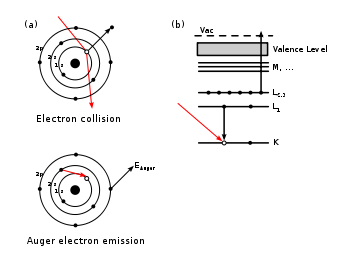Auger effect

The Auger effect /oʊˈʒər/ is a physical phenomenon in which the filling of an inner-shell vacancy of an atom is accompanied by the emission of an electron from the same atom.[1] When a core electron is removed, leaving a vacancy, an electron from a higher energy level may fall into the vacancy, resulting in a release of energy. Although most of the time this energy is released in the form of an emitted photon, the energy can also be transferred to another electron, which is ejected from the atom. This second ejected electron is called an Auger electron,[2] after one of its discoverers, Pierre Victor Auger.
Upon ejection the kinetic energy of the Auger electron corresponds to the difference between the energy of the initial electronic transition into the vacancy and the ionization energy for the electron shell from which the Auger electron was ejected. These energy levels depend on the type of atom and the chemical environment in which the atom was located. Auger electron spectroscopy involves the emission of Auger electrons by bombarding a sample with either X-rays or energetic electrons and measures the intensity of Auger electrons as a function of the Auger electron energy. The resulting spectra can be used to determine the identity of the emitting atoms and some information about their environment. Auger recombination is a similar Auger effect which occurs in semiconductors. An electron and electron hole (electron-hole pair) can recombine giving up their energy to an electron in the conduction band, increasing its energy. The reverse effect is known as impact ionization.
Discovery
The Auger emission process was observed and published in 1922 by Lise Meitner,[3] an Austrian-Swedish physicist, as a side effect in her competitive search for the nuclear beta electrons with the British physicist Charles Drummond Ellis.
The French physicist Pierre Victor Auger independently discovered it in 1923[4] upon analysis of a Wilson cloud chamber experiment and it became the central part of his PhD work.[5] High-energy X-rays were applied to ionize gas particles and observe photoelectric electrons. Observation of electron tracks independent of the frequency of the incident photon suggested a mechanism for electron ionization that was caused from an internal conversion of energy from a radiationless transition. Further investigation and theoretical work showed that the effect was a radiationless effect more than an internal conversion effect by use of elementary quantum mechanics and transition rate and transition probability calculations.[6][7]
See also
- Auger electron spectroscopy
- Coster–Kronig transition
- Electron capture
- Radiative Auger effect
- Charge carrier generation and recombination
- Auger therapy
References
- ↑ IUPAC, Compendium of Chemical Terminology, 2nd ed. (the "Gold Book") (1997). Online corrected version: (2006–) "Auger effect".
- ↑ IUPAC, Compendium of Chemical Terminology, 2nd ed. (the "Gold Book") (1997). Online corrected version: (2006–) "Auger electron".
- ↑ L. Meitner (1922). "Über die Entstehung der β-Strahl-Spektren radioaktiver Substanzen". Z. Physik 9 (1): 131–144. Bibcode:1922ZPhy....9..131M. doi:10.1007/BF01326962.
- ↑ P. Auger: Sur les rayons β secondaires produits dans un gaz par des rayons X, C.R.A.S. 177 (1923) 169-171.
- ↑ Duparc, Olivier Hardouin (2009). "Pierre Auger – Lise Meitner: Comparative contributions to the Auger effect". International Journal of Materials Research (formerly Zeitschrift fuer Metallkunde) 100 (09): 1162. doi:10.3139/146.110163.
- ↑ "The Auger Effect and Other Radiationless Transitions". Burhop, E.H.S., Cambridge Monographs on Physics, 1952
- ↑ "The Theory of Auger Transitions". Chattarji, D., Academic Press, London, 1976